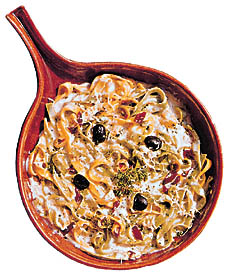Munch away to happiness
Young
concern
By Jasleen
Kaur
EAT and stay slim is the slogan of
the 21st century and to do this exercise is the key word.
The strong and muscular are in, the weak and skinny are
out. Thin people start losing their mental and physical
capabilities much before they reach middle age.Around the
world, the buxom and muscular are being viewed as more
desirable than the skinny and emaciated.
 Weak
persons are more vulnerable to fatigue, infection,
arthritis, spondylitis, blood pressure and other diseases
as they lack resistance, stamina and endurance. They tend
to suffer from cramps and constant headaches. Besides,
their immune system is also weak. Owing to their morbid
obsession with slimming and dieting, they start suffering
from psychosomatic and psychological illnesses. Weak
persons are more vulnerable to fatigue, infection,
arthritis, spondylitis, blood pressure and other diseases
as they lack resistance, stamina and endurance. They tend
to suffer from cramps and constant headaches. Besides,
their immune system is also weak. Owing to their morbid
obsession with slimming and dieting, they start suffering
from psychosomatic and psychological illnesses.
On the contrary, those
who eat well and exercise regularly have a glowing
complexion. Their skin remains taut. They do not develop
bags and dark circles around their eyes.Sufficient food
and work-outs strengthen their muscles and line them with
fat and fibre which act as shock absorbers against
fractures and usual wear and tear.
Strong tissue fibres
strengthen their knees, ankles, elbows, shoulders and hip
joints. Heavy dieters cannot do strenuous exercises like
running, swimming and work-out in a gym. They cannot play
games like tennis, football, basketball and badminton.
On the contrary, those
who eat well tend to be strong and happy.
They display better
postures whereas dieters have sloppy and awkward
postures. They also remain in constant physical
pain.Weakness makes them sullen and withdrawn.
In case of a disease or
infection the recovery rate of dieters is much slower
than of those who eat well. One should always consume
food items which contain lots of roughage and fibre.
Fruits and vegetables are rich in roughage while juices
are quite easy to digest. Such foods also protect one
from diseases like cancer, constipation, diabetes and
blood pressure. If one is able to eat 24 to 25 grams of
roughage a day, one can lower the chances of a heart
attack by 25 to 30 per cent.
|

![]()

